![]()
![]()
![]()
Use LEFT and RIGHT arrow keys to navigate between flashcards;
Use UP and DOWN arrow keys to flip the card;
H to show hint;
A reads text to speech;
24 Cards in this Set
- Front
- Back
|
What is the quality of a murmur caused by mitral regurgitation?
|
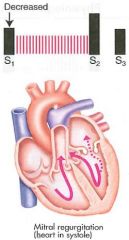
most often heard at the apex, this systolic mitral regurg is medium to high pitch with a harsh sound. it does not become louder with inspiration like a tricuspid regurg. it is caused by the mitral valve failing to close fully in systole causing blood to leak back into the L atria from the L ventricle.
|
|
|
What is the quality of a holosystolic tricuspid regurg?
|
heard at the lower left sternal border to the right of the sternum somtimes near the left-mid clavicular line, but not into the axilla, tricuspid regurg is a blowing holosystolic medium pitched murmur. it is unlike mitral regurg in that the intensity may increase slightly with inspiration.
when the tricuspid valve fails to close fully in systole, blood will leak back into the R atrium. the most common cause is R ventricular failure and dilation which causes enlargement of the tricuspid orific. pulmonary HTN or L ventricular failure is the initiating cause. |
|
|
What is the quality of a holosystolic tricuspid regurg?
|

heard at the lower left sternal border to the right of the sternum somtimes near the left-mid clavicular line, but not into the axilla, tricuspid regurg is a blowing holosystolic medium pitched murmur. it is unlike mitral regurg in that the intensity may increase slightly with inspiration.
when the tricuspid valve fails to close fully in systole, blood will leak back into the R atrium. the most common cause is R ventricular failure and dilation which causes enlargement of the tricuspid orific. pulmonary HTN or L ventricular failure is the initiating cause. |
|
|
What is the clinical quality of holosystolic ventricular septal defect?
|
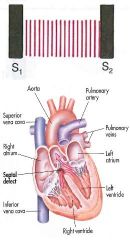
VSD heard in the 3rd, 4th, and 5th L interspaces is often very loud with a thrill. it is high pitched and holosystolic with a harsh quality.
it is a congenital septal defect where blood flows from the relatively high pressured L ventricle into the R ventricle through a hole. |
|
|
What is the clinical quality of aortic stenosis?
|
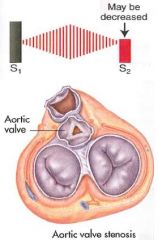
aortic stenosis is a crescendo-decrescendo early-mid systolic murmer heard in the right 2nd interspace. you can often also hear it in the carotids, down the left sternal border and even to the apex. it is often loud with a thrill and a medium harsh pitch. this murmur is heard best with the pt sitting and leaning forward.
blood flow is impaired and L ventricular afterload increases. its caused by congenital, rheumatic and degerative conditions. |
|
|
What clinical conditions may mimic aortic stenosis without obstructing blood flow?
|
aortic sclerosis, age related aortic valve leaflet stiffening, bicuspid aortic valve, dilated aorta
|
|
|
What is the clinical quality of hypertrophic cardiomyopathy?
|
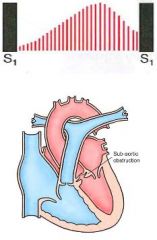
this murmur is early-mid systolic murmur heard in the 3rd and 4th left interspaces and downt he left sternal border to the apex. it is a medium pitched harsh murmer that decreases with squatting, but increases with valsalva and standing.
this hypertrophy causes rapid ejection of blood from L ventricle which can sometimes be accompanied by mitral valve distortion -> regurg. |
|
|
What is the clinical quality of pulmonic stenosis?
|
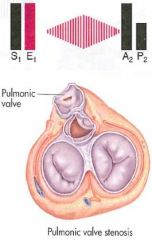
this is an early-mid systolic stenosis heard in the 2nd and 3rd interspaces that can sometimes be heard in the left shoulder and neck. it is a harsh medium crescendo-decrescendo murmur.
impeding flow causes R ventricle afterload increase. it is congenitally found in children. |
|
|
What can clinically mimic pulmonic stenosis?
|
in atrial septal defect, the systolic murmur from pathologically increased flow across the pulmonic valve may mimic pulmonic stenosis.
|
|
|
What is the clinical quality of mitral valve prolapse?
|
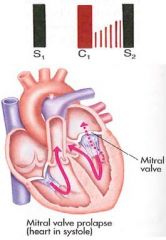
this mid-late systolic murmur can be heard at the apex and left lower sternal border it has a medium pitched crescendo quality.
the valve is competent early, then prolapses into the L atrium in late systole. it usually causes a mid-systolic click. |
|
|
What is the clinical quality of Stills murmur?
|
this is a physiological murmur located on the lower left sternal border. it is musical, vibratory and diminishes with inspiration, sitting or standing, which is the opposite of hypertrophic cardiomyopathy.
|
|
|
What is the clinical quality of a pulmonary flow murmur?
|
this is a physiological murmur located in the left upper sternal border. there is a low to intermediate pitch that diminishes with inspiration, sitting or standing.
|
|
|
What is the clinical quality of aortic regurg?
|
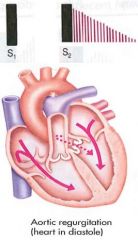
this is an early diastolic murmur that can be heard in the L 2nd and 4th interspaces. if loud enough it can be heard at the apex and sometimes at the R sternal border. it's high pitched blowing decrescedos can sometimes be mistaken for breath sounds. one can hear it best with the pt sitting and leaning forward with breath held after exhalation.
volume overload on the L ventricle results. |
|
|
What other two mumurs are associated with aortic regurgitation?
|
1. a mid-systolic murmur from the resulting increased forward flow across the aortic valve
2. a mitral diastolic (Austin Hint) murmur, attributed to diastolic impingement of the regurgitant flow on the anterior leaflet of the mitral valve. |
|
|
What is the clinical quality of pulmonic regurgitation?
|
this is an early diastolic regurg that can be heard in the 2nd to 4th L interspaces. it is a high pitched, blowing decrescendo best heard with the pt sitting with breath held after inhalation.
blood regurg from pulmonary arteries back into R ventricle |
|
|
What is the clinical quality of an atrial myxoma?
|
this is a mid-late diastollic murmur often with an early diastolic sound called a tumor plop.
one may heard an S3 or S4, and an atrial myxoma may cause a diastolic rumble or a holosystolic rumble secondary to tricuspid regurg. |
|
|
What is the clinical quality of mitral valve stenosis?
|
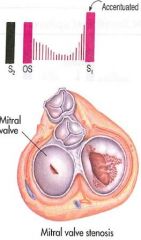
this is a mid-late diastolic murmur that is heard exclusively at the apex. it is best heard with the bell to distinguish the decrescendo low-pitched rumble in the left lateral position. mild exercise assists with being able to hear this murmur as well as focusing on the sound during exhalation.
there are two components to this murmur: 1. mid-diastolic during rapid ventricular filling 2. pre-systolic during atrial contraction (only present if atrial fibrillation is NOT present) |
|
|
What is the clinical quality of patent ductus ateriosis?
|
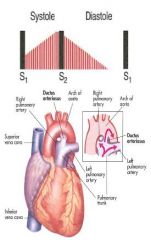
this is a continuous murmur (both diastolic and systolic). it is loudest in late systole and obscures S2. it can be heard in the L 2 interspace and has a medium pitched harsh, machinery-like sound
|
|
|
What is the clinical quality of a pericardial friction rub?
|
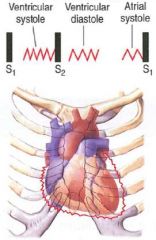
this sound is continuous and may have three short components:
1. atrial systole 2. ventricular systole 3. ventricular diastole it is a high pitched, scratchy scraping sound that is best heard in the 3rd interspace and may increase when pt leans forward, exhales, and holds breath (in contrast to pleural rub) |
|
|
What 8 qualities should be used to describe a heart murmur?
|
1. intensity (Systolic 1-6 or Diastolic 0-4)
2. pitch (high, medium, low) 3. quality (harsh, musical, blowing, crescendo, decrescrendo) 4. duration and timing in cardiac cycle (early, mid, or late systole or diastole) 5. location (2nd R interspace) 6. radiation (to neck or axillae) 7. relationship to respiration (decreased or increased with respiration) 8. relationship to body position (decreased with squatting) |
|
|
What is a TTE and a TEE?
|
TTE - transthoracic echo
TEE - transesophageal echo |
|
|
What spinal segments can influence innervation to the heart and should be considered relevant in an OMM CV exam?
|
upper cervical and thoracic
|
|
|
What spinal segments can influence parasympathetic innervation and should be considered relevant in an OMM CV exam?
|
upper cervical
|
|
|
What spinal segments can disrupt sympathetic innervation to the heart and should be considered relevant in an OMM CV exam?
|
T2-T6
|

